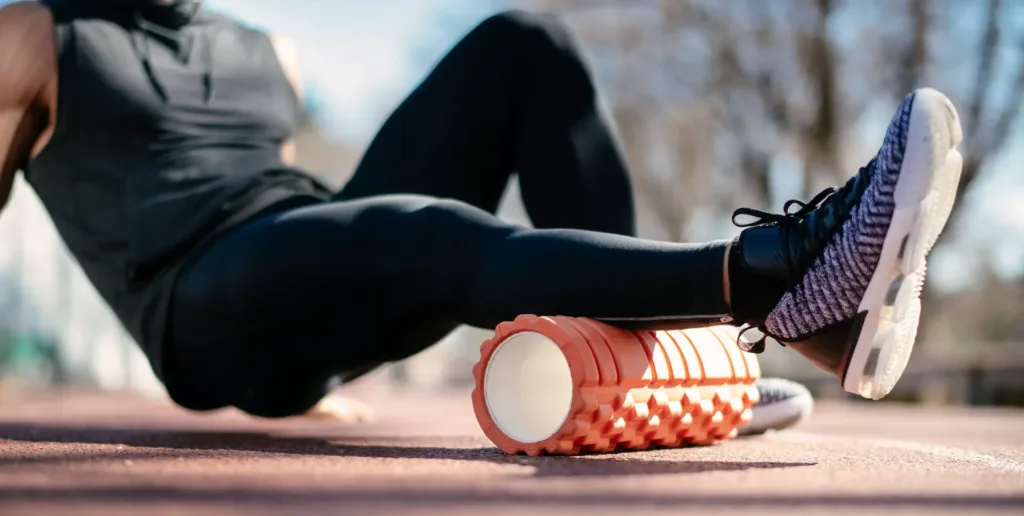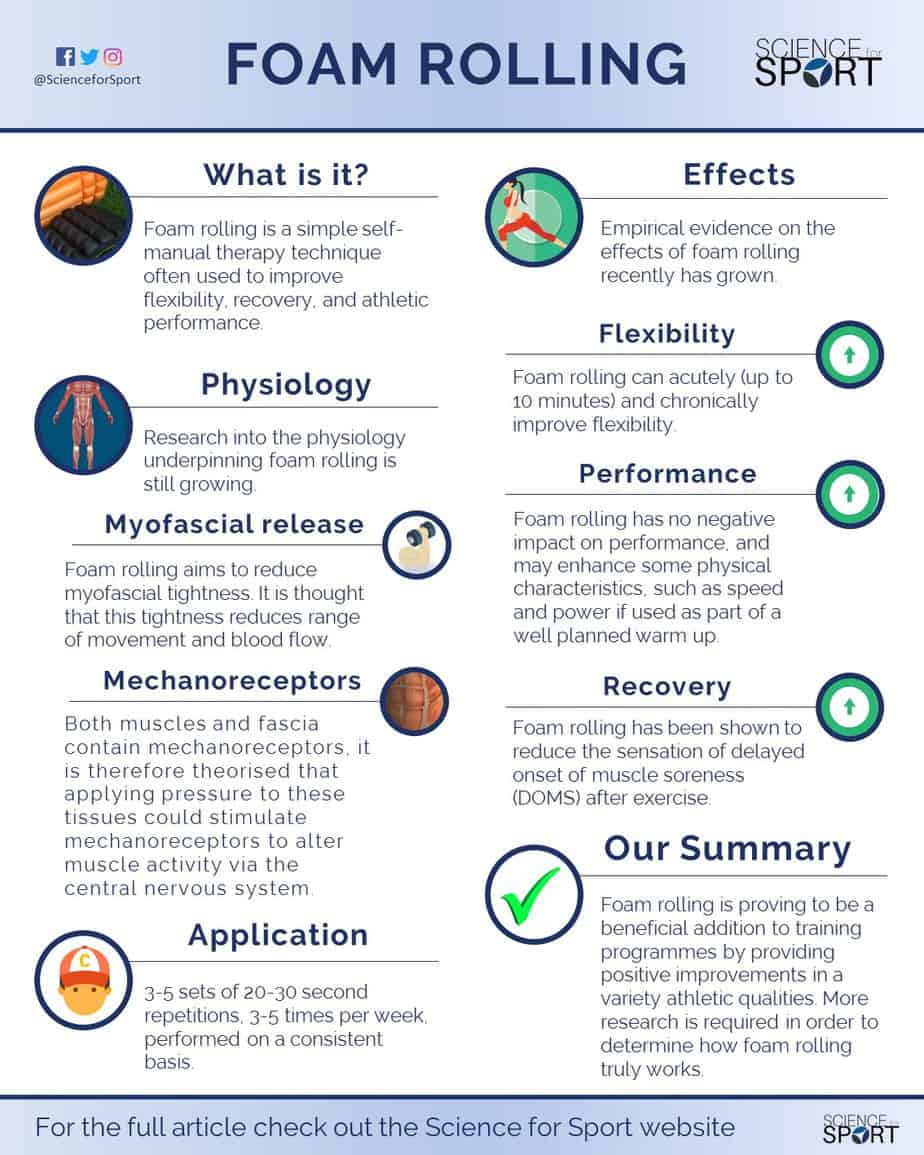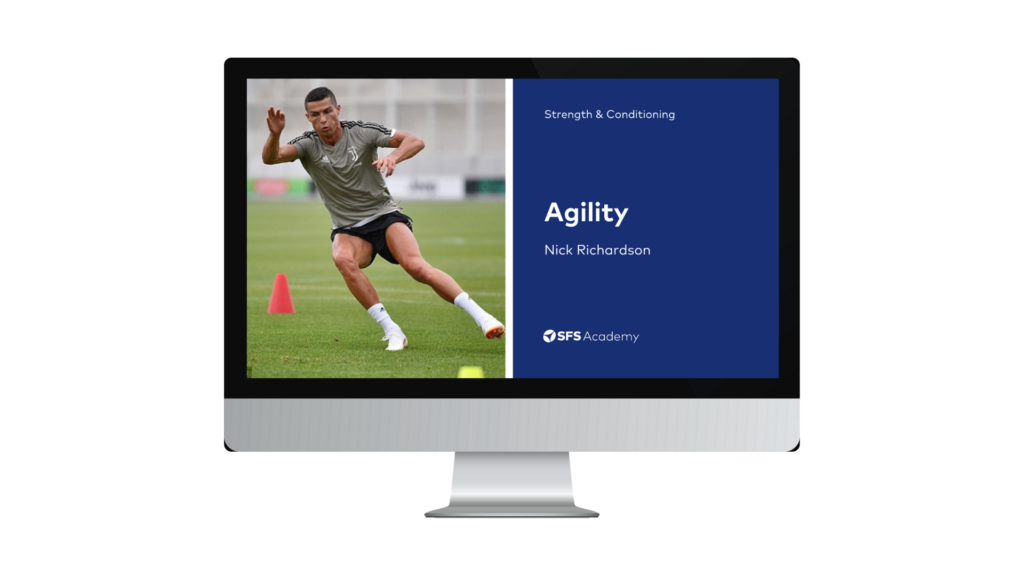Contents of Article
- Summary
- What is roam rolling?
- How does foam rolling work?
- What are the effects of foam rolling?
- Issues with Foam Rolling
- What future research is needed with foam rolling?
- How should you use foam rolling?
- Conclusion
- References
- About the Author
Summary
Foam rolling is a simple self-manual therapy technique often used to improve flexibility, recovery, and athletic performance. Though much more research is needed to clarify the effects of foam rolling, recent investigations have indicated that it is an effective method for improving flexibility, subjective markers of recovery (i.e. delayed onset of muscular soreness, or DOMS), and athletic performance. Furthermore, as no optimal sets/reps/durations have yet to be identified, it may be suggested the following recommendations provide the current best guidelines based on the available research:
- 3-5 sets of 20-30 second repetitions.
- 3-5 times per week performed on a consistent basis to achieve and retain the chronic effects on flexibility.

What is foam rolling?
Used by an abundance of fitness enthusiasts and athletes, foam rolling has now become arguably the most popular form of self-manual therapy, overtaking other techniques such as self-massage and self-trigger point therapy. Although these techniques are often referred to as self-myofascial release therapy, there is currently great confusion amongst experts regarding this definition as the true effects of foam rolling on myofascial release are still not entirely understood. In the meantime, perhaps the use of ‘self-manual therapy’ should be the preferred term to avoid any confusion or conflict of opinion.
This form of self-manual therapy is often used for three primary reasons:
- Increase flexibility.
- Reduce the DOMS and improve recovery.
- Improve short-term athletic performance.
Whilst there is a modest amount of research to support the effectiveness of the first two points (1, 2, 3), there is a significant lack of research to support its effects on improving athletic performance (4). Regardless, foam rolling is typically used during warm-up and cool-down routines to prepare the athlete for physical activity, and attempt to reduce the effects of DOMS and promote recovery.
How does foam rolling work?
As previously mentioned, the impact of foam rolling on myofascial release remains elusive, however, this article will discuss some of the research-based evidence of this self-manual therapy technique.
What is the Myofascia?
The word ‘myo’ refers to the Latin term for muscle. The term ‘fascia’ has previously been described as “the soft-tissue component of the connective tissue system that permeates the human body, forming a continuous, whole-body, three-dimensional matrix of structural support. It interpenetrates and surrounds all organs, muscles, bones, and nerve fibres, creating a unique environment for body systems functioning.” (5). Despite there being disagreement in the definition of fascial tissue, this explanation provides sufficient understanding whilst remaining relatively well-worded.
The term ‘myofasica’ therefore refers to the complex interaction between these two soft tissues.
What is myofascial release?
Myofascial release is a form of manual therapy intended to have a direct effect on the myofascial complex by reducing localised tightness. In simpler words, foam rolling is a form of self-manual therapy that aims to reduce myofascial tightness. The current belief is that this localised tightness causes restrictions in joint range of motion (ROM) and local blood flow (6), and that manual manipulation of this tension will enable the tissue to become softer and more pliable (7). In addition to muscle tissue, research has proven that fascia also contains mechanoreceptors.
As a result, it is thought the pressure applied by foam rolling reduces the localised myofascial tightness by stimulating the fascial mechanoreceptors to signal the central nervous system to alter the activity of the muscle(s) below (8). However, due to the lack of research and understanding on this topic, this theory still remains a matter of speculation.
What are the effects of foam rolling?
Foam rolling has become a staple in the majority of athletic training programmes and even for recreational use, simply due to its practicality and alleged performance-enhancing effects such as increased ROM, enhanced recovery, and improved performance. Whilst these effects have been primarily based upon practical knowledge, scientific empirical evidence on this topic has begun to grow and identify the true impacts of foam rolling on performance.
Foam Rolling and Flexibility
In the past few years, many investigations have been conducted on the effects of foam rolling on flexibility (1, 2, 3, 9, 10, 11, 12). Evidence has shown foam rolling does improve short-term (acute) flexibility and that this improvement lasts up to, but no longer than, 10 minutes (1, 2, 3). Moreover, foam rolling has also been shown to improve long-term (chronic) flexibility when it is performed on a regular basis (9, 10, 11). Whilst foam rolling has been proven to increase joint ROM, there appears to be no further improvement in flexibility between five sets of 20- and 60-second repetitions – meaning a 20-second repetition seems to be just as effective as 60 seconds (12).
Foam Rolling and Performance
Historically, static stretching has been a cornerstone of a typical warm-up routine to increase flexibility, at least until recent years where it has been shown to reduce force production (13, 14), power output (15), running speed (16), reaction time (17), and strength endurance (18). In addition to dynamic stretching, foam rolling has also been making an introduction into warm-up routines almost as a replacement to static stretching, or at least as an additive.
Despite a lack of research on the topic, foam rolling has repeatedly been shown to have no negative impact on athletic performance (2, 19, 20). In fact, one study has shown foam rolling can even improve subsequent power, agility, strength, and speed when used in conjunction with dynamic preparatory movements (4). As a result, perhaps foam rolling makes a worthwhile addition to general warm-up routines.
Foam Rolling and Recovery
One of the prime reasons for the use of foam rolling is to speed up the recovery process post-exercise and reduce the effects of DOMS. However, until recent years there has been very little evidence-based information to validate the effectiveness of this technique. However, recent research has demonstrated that foam rolling can reduce the sensation of DOMS following exercise (1, 3, 21).
Apart from the positive effects of foam rolling upon DOMS, little else is known regarding how foam rolling can influence the speed of recovery from physical activity. Regardless, the ability of foam rolling to reduce the sensations of DOMS following exercise should suggest that this technique may serve as a valuable tool for athletes – particularly during strenuous training and competition periods.

Are there any issues with foam rolling?
In addition to there being a substantial lack of underpinning knowledge with regard to how foam rolling truly affects flexibility, performance, and recovery, there is also a great paucity of information surrounding its practical application. For example, there are large variances in the methods used to roll particular muscle groups. Furthermore, there are also great discrepancies with regards to sets and repetitions to achieve optimal results without wasting precious training time.
Put simply, not enough is known in terms of the best ways to roll particular muscle groups, nor the best sets and repetitions to use either.
What future research is needed with foam rolling?
Research in the field of foam rolling is still in its infancy with many topics still needing further exploration, some of which are:
- The interaction between foam rolling, mechanoreceptors, and muscle activity.
- Foam rolling’s ability to improve athletic performance (e.g. jumping, sprinting, and strength)
- Foam rolling and recovery – its effects on subjective and objective measures.
- Optimal protocols for the practical application of foam rolling (e.g. sets and repetitions).
- Foam rolling’s effect on diverse populations (e.g. genders, ages, and sporting level).
How should you use foam rolling?
Although still somewhat inconclusive, foam rolling’s ability to improve flexibility, speed, strength, power, and agility suggests this form of self-manual therapy may be a worthwhile addition to warm-up regimes. Moreover, due to its capability of reducing the effects of DOMS following physical activity, it may also provide a meaningful addition to recovery protocols following exercise, particularly during intense training and competition periods.
After reviewing the current body of research, the following practical protocols are suggested for potentially optimal results:
- 3-5 sets of 20-30 second repetitions.
- 3-5 times per week performed on a consistent basis to achieve and retain the chronic effects on flexibility.
Conclusion
As foam rolling has become such a significant part of both athletic and fitness enthusiasts’ training programmes, there has been an increasing demand for researchers to identify the true effects of this therapeutical modality. At present, this form of self-manual therapy is proving to be a beneficial addition to physical training programmes by demonstrating positive improvements in a variety of athletic qualities.
More research is needed to better understand how foam rolling really works, but for now, it can be suggested that this modality can provide a meaningful impact on training if applied in the correct manner.
- Jay, K., Sundstrup, E., Søndergaard, S. D., Behm, D., Brandt, M., Særvoll, C. A., & Andersen, L. L. (2014). Specific and cross over effects of massage for muscle soreness: randomized controlled trial. International journal of sports physical therapy, 9(1), 82-91. [PubMed]
- Halperin, I., Aboodarda, S. J., Button, D. C., Andersen, L. L., & Behm, D. G. (2014). Roller massager improves range of motion of plantar flexor muscles without subsequent decreases in force parameters. International journal of sports physical therapy, 9(1), 92. [PubMed]
- MacDonald, G. Z., Penney, M. D., Mullaley, M. E., Cuconato, A. L., Drake, C. D., Behm, D. G., & Button, D. C. (2013). An acute bout of self-myofascial release increases range of motion without a subsequent decrease in muscle activation or force. The Journal of Strength & Conditioning Research, 27(3), 812-821. [PubMed]
- Peacock, C.A., Krein, D.D., Silver, T.A., Sanders, G.J., von Carlowitz, K.P.A. (2014). An acute bout of self-myofascial release in the form of foam rolling improves performance testing. International Journal of Exercise Science, 7(3), pp.202-211. [Link]
- Findley, T. W. (2009). Second international fascia research congress. International Journal of Therapeutic Massage & Bodywork, 2(2),
- Findley, T., Chaudhry, H., Stecco, A., & Roman, M. (2012). Fascia research–A narrative review. Journal of Bodywork and Movement Therapies, 16(1), 67-7. [PubMed]
- Barnes, M. F. (1997). The basic science of myofascial release. Journal of Bodywork and Movement Therapies, 1(4), 231-238. [Link]
- Schleip, R., & Müller, D. G. (2013). Training principles for fascial connective tissues: Scientific foundation and suggested practical applications. Journal of bodywork and movement therapies, 17(1), 103-115. [PubMed]
- Mohr, A.R., Long, B.C., & Goad, C.L. (2014) Effect of foam rolling and static stretching on passive hip-flexion range of motion. Journal of Sport Rehabilitation, 23(4), pp.296-299. [PubMed]
- Ebrahim, A. W., & Elghany, A. W. A. (2013). The effect of foam roller exercise and Nanoparticle in speeding of healing of sport injuries. Journal of American Science, 6, 9. [PubMed]
- Miller, J. K., & Rockey, A. M. (2006). Foam rollers show no increase in the flexibility of the hamstring muscle group. Journal of Undergraduate Research IX [Link]
- Bradbury, S.D.J., Noftall, J.C., Sullivan, K.M., Behm, D.G.,Power, K.E., and Button, D.C. (2015). Roller-massager application to the quadriceps and knee-joint range of motion and neuromuscular efficiency during a lunge. Journal of Athletic Training, 50(2), pp.133-140. [PubMed]
- Cramer JT, Housh TJ, Weir JP, Johnson GO, Coburn JW, Beck TW. The acute effects of static stretching on peak torque, mean power output, electromyography, and mechanomyography. Eur J Appl Physiol. Mar;93(5- 6):530–9 2005. [PubMed]
- Cramer JT, Housh TJ, Coburn JW, Beck TW, Johnson GO. Acute effects of static stretching on maximal eccentric torque production in women. J Strength Cond Res. May;20(2):354–8 2006. [PubMed]
- Wallmann HW, Mercer JA, McWhorter JW. Surface electromyographic assessment of the effect of static stretching of the gastrocnemius on vertical jump performance. J Strength Cond Res. Aug;19(3):684–8 2005. [PubMed]
- Fletcher IM, Jones B. The effect of different warm-up stretch protocols on 20 meter sprint performance in trained rugby union players. J Strength Cond Res. Nov;18(4):885–8 2004. [PubMed]
- Behm DG, Bambury A, Cahill F, Power K. Effect of acute static stretching on force, balance, reaction time, and movement time. Med Sci Sports Exerc. Aug; 36(8):1397–402 2004. [PubMed]
- Nelson AG, Kokkonen J, Arnall DA. Acute muscle stretching inhibits muscle strength endurance performance. J Strength Cond Res. May;19(2):338–43 2005. [PubMed]
- Janot, J., Malin, B., Cook, R., Hagenbucher, J., Draeger, A., Jordan, M., & Quinn, E. (2013). Effects of Self Myofascial Release and Static Stretching on Anaerobic Power Output. Journal of Fitness Research, 2(1). [Link]
- Healey, K. C., Hatfield, D. L., Blanpied, P., Dorfman, L. R., & Riebe, D. (2014). The effects of myofascial release with foam rolling on performance. The Journal of Strength & Conditioning Research, 28(1), 61-68. [PubMed]
- Pearcey, G.E., Bradbury-Squires, D.J., Kawamoto, J.E., Drinkwater, E.J., Behm, D.G., and Button, D.C. (2015). Foam rolling for delayed-onset muscle soreness and recovery of dynamic performance measures. Journal of Athletic Training, 50(1), pp.5-15. [PubMed]




